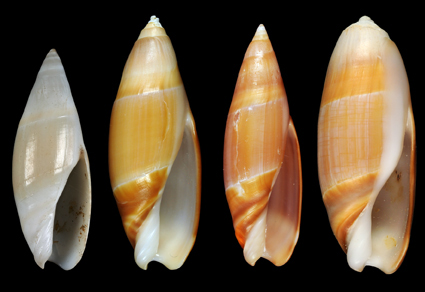Abstract
Turrancilla, a small genus of Ancillariidae, is revised based on molecular (partial cox1 sequences) and morphological data. Six species are attributed to the genus based on both molecular and morphological evidence, including one new species, T. heraldei sp. nov., from the Philippines. Two additional species are included based on morphological data alone. The status of one of these, T. apicalis Kira, 1959, from Japan, remains uncertain pending further data. One species, T. williamsoni Petuch, 1987, is excluded and provisionally assigned to Amalda. In conchological characteristics, Turrancilla can closely resemble Amalda but is readily distinguished by its radular features. The genus is primarily confined to upper bathyal depths of the Pacific, with one species, T. akontistes reaching western Indian Ocean (from Zanzibar to Mozambique and Madagascar) and one, T. sibuetae, recorded in the eastern Atlantic.
References
- Bieler, R. & Petit, R.E. (1990) On the various editions of Tetsuaki Kira’s “Coloured illustrations of the shells of Japan” and “Shells of the Western Pacific in color Vol. 1”, with an annotated list of new names introduced. Malacologia, 32, 131–145. [https://www.biodiversitylibrary.org/page/13146396]
- Chester, C., Agosti, D., Sautter, G., Catapano, T., Martens, K., Gérard, I. & Bénichou, L. (2019) EJT editorial standard for the semantic enhancement of specimen data in taxonomy literature. European Journal of Taxonomy, 586, 1–22. https://doi.org/10.5852/ejt.2019.586
- Fedosov, A., Achaz, G., Gontchar, A. & Puillandre, N. (2022) Mold, a novel software to compile accurate and reliable DNA diagnoses for taxonomic descriptions. Molecular Ecology Resources, 22, 2038–2053. https://doi.org/10.1111/1755-0998.13590
- Folmer, O., Black, M., Hoeh, W., Lutz, R. & Vrijenhoek, R. (1994) DNA primers for amplification of mitochondrial cytochrome c oxidase subunit I from diverse metazoan invertebrates. Molecular Marine Biology and Biotechnology, 3, 294–299.
- Galindo, L.A., Puillandre, N., Strong, E.E. & Bouchet, P. (2014) Using microwaves to prepare gastropods for DNA barcoding. Molecular Ecology Resources, 14, 700–705. https://doi.org/10.1111/1755-0998.12231
- Habe, T. (1943) On the radulae of Japanese marine gastropods (1). Venus, 13 (1–4), 68–76, pls. 3–4.
- Hall, T.A. (1999) BioEdit: a user-friendly biological sequence alignment editor and analysis program for Windows 95/98/NT. Nucleic Acids Symposium Series, 41, 95–98.
- Higo, S., Callomon, P. & Goto, Y. (1999) Catalogue and bibliography of the marine shell-bearing Mollusca of Japan. Elle Scientific Publications, Yao, 749 pp.
- Huelsenbeck, J.P., Ronquist, F. & Hall, B. (2001) MrBayes: Bayesian inference of phylogeny. Bioinformatics, 17, 754–755. https://doi.org/10.1093/bioinformatics/17.8.754
- Kantor, Yu.I. & Bouchet, P. (1999) A deep-sea Amalda (Gastropoda: Olividae) in the north-eastern Atlantic. Journal of Conchology, 36 (5), 11–16. https://doi.org/10.5962/p.408047
- Kantor, Yu.I., Fedosov, A.E., Puillandre, N., Bonillo, C. & Bouchet, P. (2017) Returning to the roots: morphology, molecular phylogeny and classification of the Olivoidea (Gastropoda: Neogastropoda). Zoological Journal of the Linnean Society, 180 (3), 493–541. https://doi.org/10.1093/zoolinnean/zlw003
- Kantor, Yu.I., Castelin, M., Fedosov, A. & Bouchet, P. (2020) The Indo-Pacific Amalda (Neogastropoda, Olivoidea, Ancillariidae) revisited with molecular data, with special emphasis on New Caledonia. European Journal of Taxonomy, 706, 1–59. https://doi.org/10.5852/ejt.2020.706
- Kantor, Yu.I. & Puillandre, N. (2012) Evolution of the radular apparatus in Conoidea (Gastropoda: Neogastropoda) as inferred from a molecular phylogeny. Malacologia, 55 (1), 55–90. https://doi.org/10.4002/040.055.0105
- Kilburn, R.N. (1980) A new Ancilla from the Arabian Sea, and a discussion of two homonyms in the Ancillinae (Mollusca: Gastropoda: Olividae). Durban Museum Novitates, 12 (14), 167–170.
- Kira, T. (1954) Coloured illustrations of the shells of Japan. Hoikusha, Osaka, [vill] + 172 + 24 pp. [title in Japanese; numerous additional printings]
- Kira, T. (1959) Coloured illustrations of the shells of Japan. 2nd Edition. 1st Printing. Hoikusha, Osaka, [6] + vii + [1] + 239 pp.
- Martens, E. von (1901) Einige Neue Meer-Conchylien von der Deutschen Tiefsee-Expedition. Sitzungsberichte der Gesellschaft Naturforschender Freunde zu Berlin, Jahrgang, 1901, 14–26. [https://www.biodiversitylibrary.org/page/8798420]
- Martens, E. von & Thiele, J. (1904) Die beschalten Gastropoden der Deutschen Tiefsee-Expedition 1898–1899. In: Chun, C. (Ed.), Wissenschaftliche Ergebnisse der Deutschen Tiefsee-Expedition auf dem dampfer "Valdivia" 1898–1899, 7, pp. 1–180, pls. 1–29. [https://www.biodiversitylibrary.org/page/6307742] https://doi.org/10.5962/bhl.title.11264
- MolluscaBase, eds. (2025) MolluscaBase. Available from: https://www.molluscabase.org (accessed 11 March 2025) https://doi.org/10.14284/4482025
- Ninomiya, T. (1988) A new subgenus and five new species of the Ancillinae (Gastropoda: Olividae) from southwestern Australia, Japan and Taiwan. Venus, 47 (3), 141–153. Available from: https://doi.org/10.18941/venusjjm.47.3_141
- Okutani, T. (Ed.) (2017) Marine mollusks in Japan. 2 Vols. 2nd Edition. Tokai University Press, Tokyo, 1375 pp.
- Petuch, E.J. (1987) New Caribbean molluscan faunas. The Coastal Education and Research Foundation, Charlottesville, Virginia, 154 pp., 29 pls; addendum 2 pp., 1 pl.
- Puillandre, N., Brouillet, S. & Achaz, G. (2021) ASAP: assemble species by automatic partitioning. Molecular Ecology Resources, 21, 609–620. https://doi.org/10.1111/1755-0998.13281
- Rambaut, A. & Drummond, A.J. (2014) Tracer. Version 1.6. Available from: http://beast.bio.ed.ac.uk/Tracer (accessed 11 March 2025)
- Rosenberg, G. (2009) Malacolog 4.1.1: A Database of Western Atlantic Marine Mollusca. WWW database. Version 4.1.1). Available from: http://www.malacolog.org/ (accessed 11 March 2025)
- Smith, E.A. (1899) Natural history notes from H.M. Indian Marine Survey Steamer ‘Investigator’, Commander T.H. Heming, R.N.—Series III., No. 1. On Mollusca from the Bay of Bengal and the Arabian Sea. Annals and Magazine of Natural History, Series 7, 4 (22), 237–251. https://doi.org/10.1080/00222939908678195
- Tamura, K., Stecher, G., Peterson, D., Filipski, A. & Kumar, S. (2013) MEGA6: Molecular evolutionary genetics analysis Version 6.0. Molecular Biology and Evolution, 30, 2725–2729. https://doi.org/10.1093/molbev/mst197


